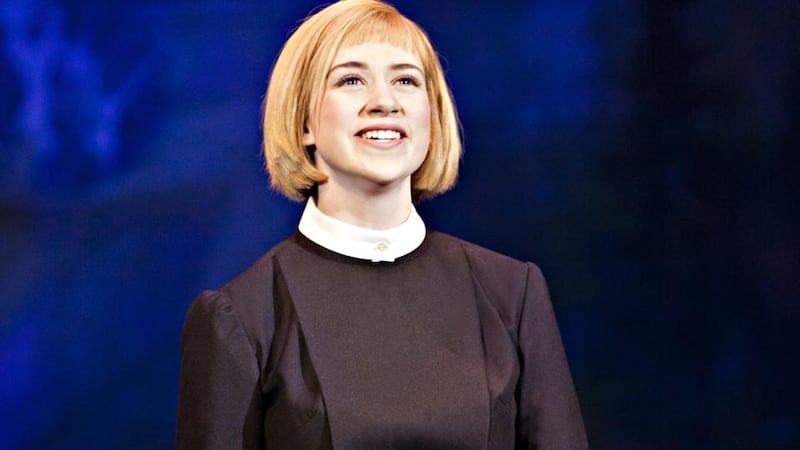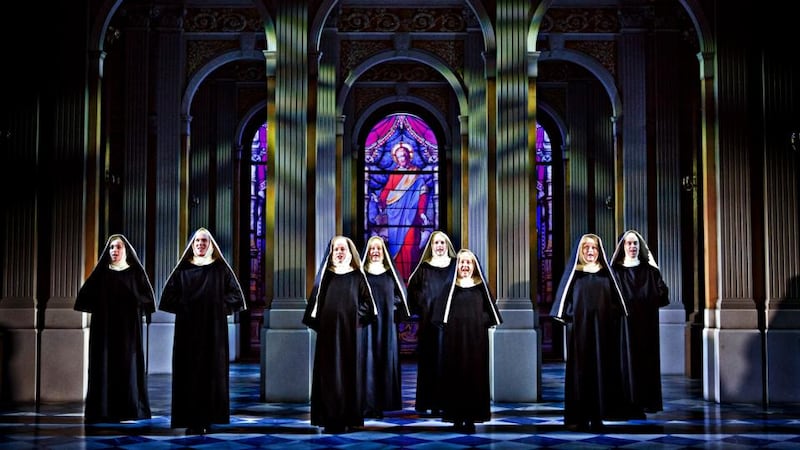It is 50 years since Julie Andrews threw her arms open and declared the hills alive with the sound of music, but still no one has answered a very important question: how do you hold a moonbeam in your hand?
The film that won five Academy Awards and collected big at the box office in 1965 has remained a favourite with successive generations who know it from repeated small-screen showings. But the original The Sound of Music stage show, coming to Dublin's Bord Gáis Energy Theatre from August 17th, is its own pleasure, as its star, the super-endearing Danielle Hope, has only recently discovered.
Before she won the role of uncatchable cloud Maria Rainer, wayward postulant turned empathic governess, Hope had seen Robert Wise’s film, but not the stage musical, which predates it by six years. Then, almost as soon as she won the role for the 2015 UK and Ireland tour, Hope found herself yodelling first thing in the morning in preparation for her debut “adult” lead.


"I'm not making it easy for myself with these iconic roles, going from ruby slippers to Éponine in Les Mis to Maria," says Hope.
"Ruby slippers" is a reference to her breakout role as Dorothy in The Wizard of Oz. Hope played it for a year at the London Palladium after winning the role on the BBC series Over the Rainbow. That television show was very public audition process that saw Hope, always a favourite with the judges, win over the voting masses.
In the clichéd vernacular of TV talent contests, Hope made songs such as Mambo Italiano and a duet on Popular from Wicked her own, at a time when she had little professional theatre experience.
The Manchester performer turned 18 while competing on the Saturday teatime show and is still only 23. This is a great deal younger than original Maria Mary Martin was at the time of the show’s 1959 Broadway premiere. It is also younger too than Andrews when she played the unsolvable problem.
“Even if I tried to imitate Julie Andrews, it would never come across that way because I’m Danielle,” Hope says, crediting this tour’s director, Martin Connor, with encouraging “light and shade” in their performances.
Owing to an unfortunate bout of bronchitis, Hope was missing in action during last month's press preview at the Bristol Hippodrome. So Maria was ably understudied by friend and fellow Over the Rainbow contestant Jessica Daley, who was both free-spirited and wise in the role without being schoolmarmish. I did see Hope charm the Palladium in those ruby slippers in 2011, and on that evidence it's hard to see how her Maria could be anything other than excellent casting.
In a post-recovery chat, Hope describes herself as "being in that tricky age where you can sort of play both these young girls and these adult leads". Maria is the perfect in-between role: "Maria goes on this huge transition in the show and I see myself as being on that same path in my career." With Maria's marriage to Capt von Trapp, the role brings her first "love connection", she adds. She discounts tragic Éponine's unrequited love in Les Misérables. "Poor Éponine couldn't quite get Marius," she laughs.
The prototype for the stage Maria was born on a moving train heading to Vienna in 1905 and married the widower Baron Georg von Trapp in 1927.
She later wrote that she “liked him but didn’t love him” and that it was his children (who in reality were already musically gifted) that she really married.
Although The Sound of Music has Maria falling for the Captain, in a way it is still faithful to this element of the real story – the von Trapp children are clearly at its heart. Hope cites The Lonely Goatherd as her favourite to perform, partly because it wasn't the easiest to master ("I used to be a bit terrified of singing it, because it's so many words to sing"), but also because it is where Maria cements her relationship with the seven motherless children.
“A lot of my lines are responsive, so I really have to go along with what the children do. And they’re so energised and inspired,” Hope says. Employment laws mean there are three sets of child actors playing the six younger von Trapps. (Grace Chapman, who plays Liesl, is old enough to avoid triplication.) The rotation gives Hope’s interaction with the children an added freshness each night.
The 1965 film demoted the yodelling feast that is The Lonely Goatherd to a superfluous piece of whimsy in which Maria and the children put on a puppet show for the grown-ups. In this production it is returned to its original position and meaning as a cheerful distraction during a thunderstorm. (My Favourite Things, which slots into this scene in the film, has already been knocked out in the abbey.)
Another noticeable departure from the film is the absence of the ebullient I Have Confidence, one of two songs written specially for the film. This production also restores what is perhaps its least well-known song, How Can Love Survive?, performed by rich socialite Elsa and the Captain's ever-pragmatic friend Max.
While Maria is clearly the lead role, The Sound of Music, composed by Richard Rodgers with lyrics by Oscar Hammerstein II and a book (script) by Howard Lindsay and Russel Crouse, is democratic in its distribution of the big numbers. The children repeatedly out-cute each other during The Lonely Goatherd, Maria's musical tutorial Do-Re-Mi and So Long, Farewell. The opening bars of the latter (with the lyric "There's a sad sort of clanging from the clock in the hall") is my favourite part of the entire score.
That's closely followed by Liesl's irony-dripping response to Rolfe in Sixteen Going on Seventeen. It really is a classic musical tune in that it allows for playful choreography but also has that trick of souring from light-and-bouncy to bittersweet in a single line. In the second half of the song, Liesl, having been told she is an "empty page that men will want to write on", undercuts mansplainer Rolfe while, amazingly, still flirting with him. No wonder he doesn't shop her to the Nazis at the end.
The big moment for the Captain (Steven Houghton) is when he delivers the solemnly patriotic Edelweiss at a concert stuffed to the rafters with fascists. Edelweiss is intended as a slow chill of a song, poured out amid the knowledge that persecution is about to ensue.
"I'm a high baritone, really, so it took a while for me to find the right place in my voice for it to sit," says Houghton of Edelweiss. In this production, the emphasis of the Captain's character leans more towards his admirably unbending political principles than it does his initial sternness. Still, Houghton says he enjoys the comedy of introducing the children in the scene in which he reveals his method of parenting to be largely whistle-based.
Meanwhile, it is the Mother Abbess (Jan Hartley) who gets to close a lengthy first act with the operatic Climb Ev'ry Mountain, which involves "a bit of pressure", says Hartley, a seasoned performer who knows this show well, having played Maria herself on a UK national tour in 1986.
"I think it was The Sound of Music that actually got me into singing," Hartley says. "It's just such a lovely show to be a part of. There are some shows that audiences love, but you don't necessarily enjoy them that much. But when something is beautifully written, you can always tell because it just flows. It's very well constructed, don't you think?"
Indeed, it is neatly plotted, creating in Maria the kind of all-round heroine who will not only emotionally liberate those around her, but physically get her new family out of trouble. Hope almost forgets to mention that her other nightly highlight is the tone-setting title song. "Sometimes [backstage] I call it Over the Rainbow by accident," she says – it's that important to the show.
Having established at the very beginning that unconventional roamer Maria could “never get lost up there” on the mountains, her knowledge secures the von Trapps’ exit route from Nazi-occupied Austria into safe Switzerland.
Not bad for a flibbertigibbet.
The Sound of Music plays at the Bord Gáis Energy Theatre, Dublin from August 17th to 29th. See bordgaisenergytheatre.ie













